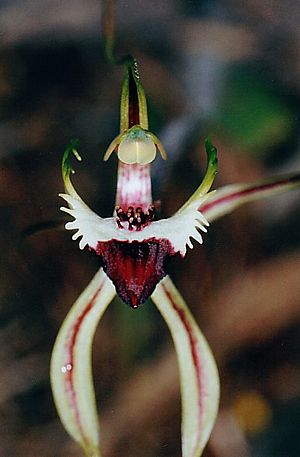Rigid spider orchid facts for kids
Quick facts for kids Rigid spider orchid |
|
|---|---|
 |
|
| Caladenia tensa growing in the Little Desert N.P. | |
| Conservation status | |
| Scientific classification | |
| Genus: |
Caladenia
|
| Species: |
tensa
|
| Synonyms | |
|
Arachnorchis tensa (G.W.Carr) D.L.Jones & M.A.Clem. |
|
The Caladenia tensa, also known as the rigid spider orchid, is a special plant in the orchid family. It grows only in southern Australia. This orchid grows from the ground and has a single leaf. Its flowers are pale green with red stripes.
You can mostly find this orchid in the Little Desert National Park in Victoria. It also grows in the far south-east of South Australia. There have been a few times it was seen in New South Wales.
Contents
What Does the Rigid Spider Orchid Look Like?
The rigid spider orchid is a plant that lives for many years (it's a perennial). It's also a deciduous plant, meaning it loses its leaves at certain times. It's a herb that grows from an underground tuber (like a small potato).
It has one long, hairy leaf, about 6 to 12 centimeters (2.4-4.7 inches) long and 1 to 1.5 centimeters (0.4-0.6 inches) wide. This leaf often has red spots near its base.
One or two pale green flowers grow on a stalk that is 20 to 30 centimeters (7.9-11.8 inches) tall. These flowers have red stripes and are about 4 to 5 centimeters (1.6-2 inches) wide.
- Sepals and Petals: The sepals and petals are like the flower's "outer leaves." They have thin, yellowish, club-like tips that are 6 to 12 millimeters (0.2-0.5 inches) long.
- The top sepal stands straight up.
- The side sepals and petals spread out a bit and point downwards.
- Labellum: The labellum is a special lip-like part of the orchid flower. It's about 1.8 to 2 centimeters (0.7-0.8 inches) long and 1.8 to 2.2 centimeters (0.7-0.9 inches) wide. It's pale green with a white center and a dark red tip.
- The sides of the labellum have thin green "teeth" up to 4 millimeters (0.16 inches) long. These teeth become smaller and white near the tip.
- The tip of the labellum curls under.
- There are four rows of small bumps called calli along the middle of the labellum.
This orchid usually blooms from September to October.
How This Orchid Got Its Name
The rigid spider orchid was first officially described in 1991 by a scientist named Geoffrey Carr. He found a sample of the plant near a place called Kiata.
The scientific name tensa comes from a Latin word. It means "stretched" or "extended." This probably describes how parts of the flower look.
Where the Rigid Spider Orchid Lives
In Victoria, you can find the rigid spider orchid between Horsham and Ouyen. It also grows west towards the border with South Australia. Most of these orchids are found in the Little Desert National Park.
In the past, this orchid was also seen in some parks in South Australia, like Cape Gantheaume and Billiatt. It was also recorded near places like Lake Cargelligo in New South Wales. However, we don't know exactly where it grows in those areas today.
This orchid likes to grow in forests with eucalyptus and cypress trees.
Protecting the Rigid Spider Orchid
The rigid spider orchid is considered "endangered" by the Australian Government. This means it's at a high risk of disappearing forever. In Victoria, it's listed as "vulnerable," which also means it needs protection.
The biggest dangers to this orchid are:
- Habitat loss: When the places where it grows are destroyed or changed.
- Weed invasion: When other plants (weeds) take over its living space.
- Grazing: When animals like rabbits eat the plants.
Scientists are still learning about how fires affect this special orchid.
Images for kids



